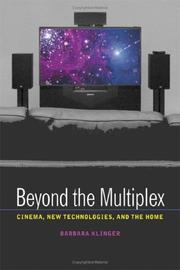| Listing 1 - 2 of 2 |
Sort by
|
Book
ISBN: 022659372X Year: 2019 Publisher: Chicago : University of Chicago Press,
Abstract | Keywords | Export | Availability | Bookmark
 Loading...
Loading...Choose an application
- Reference Manager
- EndNote
- RefWorks (Direct export to RefWorks)
From the turn of the twentieth century through the late 1950s, Havana was a locus for American movie stars, with glamorous visitors including Errol Flynn, John Wayne, and Marlon Brando. In fact, Hollywood was seemingly everywhere in pre-Castro Havana, with movie theaters three to a block in places, widely circulated silver screen fanzines, and terms like "cowboy" and "gangster" entering Cuban vernacular speech. Hollywood in Havana uses this historical backdrop as the catalyst for a startling question: Did exposure to half a century of Hollywood pave the way for the Cuban Revolution of 1959? Megan Feeney argues that the freedom fighting extolled in American World War II dramas and the rebellious values and behaviors seen in postwar film noir helped condition Cuban audiences to expect and even demand purer forms of Cuban democracy and national sovereignty. At the same time, influential Cuban intellectuals worked to translate Hollywood ethics into revolutionary rhetoric-which, ironically, led to pointed critiques and subversions of the US presence in Cuba. Hollywood in Havana not only expands our notions of how American cinema was internalized around the world-it also broadens our view of the ongoing history of US-Cuban interactions, both cultural and political.
Motion pictures, American --- Motion pictures, American --- National liberation movements --- History --- Influence. --- Hollywood abroad. --- Republican Cuba. --- US imperialism. --- US-Cuban relations. --- film business. --- film criticism. --- film reception. --- masculinity. --- revolutionary nationalism. --- transnational.

ISBN: 1423755480 0520939077 1598759183 9780520939073 9781423755487 9781598759181 9780520223158 0520223152 9780520245860 0520245865 Year: 2006 Publisher: Berkeley University of California Press
Abstract | Keywords | Export | Availability | Bookmark
 Loading...
Loading...Choose an application
- Reference Manager
- EndNote
- RefWorks (Direct export to RefWorks)
Since the mid-eighties, more audiences have been watching Hollywood movies at home than at movie theaters, yet little is known about just how viewers experience film outside of the multiplex. This is the first full-length study of how contemporary entertainment technologies and media—from cable television and VHS to DVD and the Internet—shape our encounters with the movies and affect the aesthetic, cultural, and ideological definitions of cinema. Barbara Klinger explores topics such as home theater, film collecting, classic Hollywood movie reruns, repeat viewings, and Internet film parodies, providing a multifaceted view of the presentation and reception of films in U.S. households. Balancing industry history with theoretical and cultural analysis, she finds that today cinema's powerful social presence cannot be fully grasped without considering its prolific recycling in post-theatrical venues—especially the home.
Home theaters. --- Motion pictures and television. --- Television --- Radio vision --- TV --- Artificial satellites in telecommunication --- Electronic systems --- Optoelectronic devices --- Telecommunication --- Astronautics --- Moving-pictures and television --- Television and motion pictures --- Home motion picture theaters --- Theater rooms --- Rooms --- Social aspects. --- Technological innovations. --- Optical communication systems --- america. --- cable television. --- cinema aesthetics. --- cinema historians. --- cinemaphiles. --- contemporary film. --- cultural analysis. --- dvd. --- entertainment media. --- entertainment technology. --- ethnography. --- film industry. --- film parodies. --- film reception. --- film studies. --- hollywood. --- home theaters. --- home viewers. --- ideological perspective. --- internet films. --- internet media. --- media studies. --- movie theaters. --- movies and culture. --- nonfiction. --- post theatrical venues. --- social presence. --- theoretical. --- us households. --- vhs.
| Listing 1 - 2 of 2 |
Sort by
|

 Search
Search Feedback
Feedback About UniCat
About UniCat  Help
Help News
News